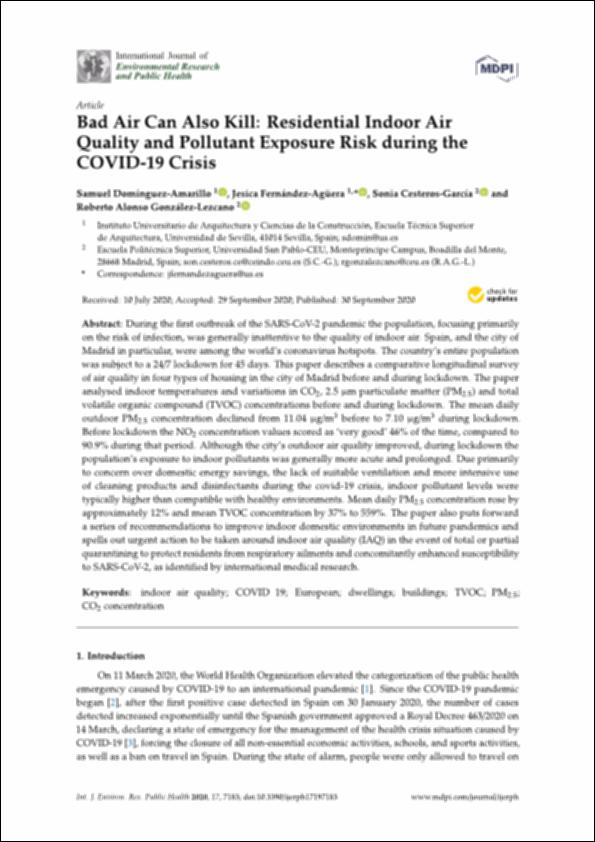Please use this identifier to cite or link to this item:
http://hdl.handle.net/10637/14590Bad Air Can Also Kill Residential Indoor Air Quality and Pollutant Exposure Risk during the COVID-19 Crisis
| Title: | Bad Air Can Also Kill Residential Indoor Air Quality and Pollutant Exposure Risk during the COVID-19 Crisis |
| Authors : | Domínguez-Amarillo, Samuel Fernández Agüera, Jessica Cesteros García, Sonia González Lezcano, Roberto Alonso. |
| Keywords: | COVID 19; Indoor air quality |
| Publisher: | MDPI |
| Citation: | Domínguez-Amarillo, S.; Fernández-Agüera, J.; Cesteros-García, S.; González-Lezcano, R.A. Bad Air Can Also Kill: Residential Indoor Air Quality and Pollutant Exposure Risk during the COVID-19 Crisis. Int. J. Environ. Res. Public Health 2020, 17, 7183. https://doi.org/10.3390/ijerph17197183 |
| Abstract: | During the first outbreak of the SARS-CoV-2 pandemic the population, focusing primarily on the risk of infection, was generally inattentive to the quality of indoor air. Spain, and the city of Madrid in particular, were among the world’s coronavirus hotspots. The country’s entire population was subject to a 24/7 lockdown for 45 days. This paper describes a comparative longitudinal survey of air quality in four types of housing in the city of Madrid before and during lockdown. The paper analysed indoor temperatures and variations in CO2, 2.5 m particulate matter (PM2.5) and total volatile organic compound (TVOC) concentrations before and during lockdown. The mean daily outdoor PM2.5 concentration declined from 11.04 g/m3 before to 7.10 g/m3 during lockdown. Before lockdown the NO2 concentration values scored as ‘very good’ 46% of the time, compared to 90.9% during that period. Although the city’s outdoor air quality improved, during lockdown the population’s exposure to indoor pollutants was generally more acute and prolonged. Due primarily to concern over domestic energy savings, the lack of suitable ventilation and more intensive use of cleaning products and disinfectants during the covid-19 crisis, indoor pollutant levels were typically higher than compatible with healthy environments. Mean daily PM2.5 concentration rose by approximately 12% and mean TVOC concentration by 37% to 559%. The paper also puts forward a series of recommendations to improve indoor domestic environments in future pandemics and spells out urgent action to be taken around indoor air quality (IAQ) in the event of total or partial quarantining to protect residents from respiratory ailments and concomitantly enhanced susceptibility to SARS-CoV-2, as identified by international medical research. |
| URI: | http://hdl.handle.net/10637/14590 |
| Rights : | http://creativecommons.org/licenses/by-nc-nd/4.0/deed.es OpenAccess |
| ISSN: | 1660-4601 |
| Issue Date: | 30-Sep-2020 |
| Center : | Universidad San Pablo-CEU |
| Appears in Collections: | Escuela de Politécnica Superior |
Items in DSpace are protected by copyright, with all rights reserved, unless otherwise indicated.


